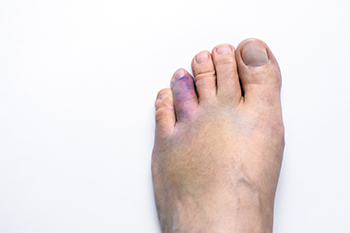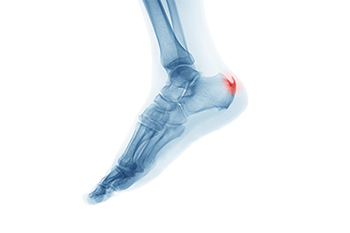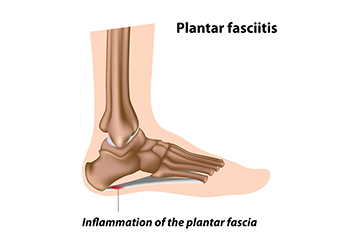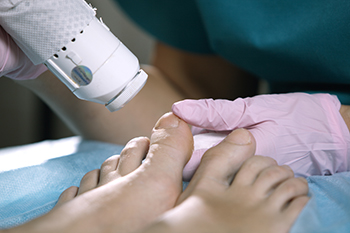Connect With Us
Blog
Items filtered by date: September 2023
Signs and Treatments for a Broken Toe

A broken toe, though relatively common, can be a painful and inconvenient injury. Knowing the signs and how to address them can expedite the healing process and prevent potential complications. Signs of a broken toe typically include immediate pain, swelling, bruising, and difficulty in moving the affected toe. In some cases, you may even hear or feel a snap or pop at the time of injury. If you suspect a broken toe, it is important to seek medical attention promptly. Having an X-ray and a physical examination performed is generally successful in diagnosing a broken toe. Treatment for a broken toe often involves immobilization, which may include splinting, or buddy taping, which is taping the injured toe to a neighboring toe. Additionally, it may be beneficial to wear a protective boot that can also provide stability and mobility. Pain management measures, such as taking over the counter pain relievers and elevating the foot, can help to alleviate discomfort and reduce swelling. Recovery time varies but typically ranges from a few weeks to a couple of months. Recognizing the signs and seeking timely treatment are essential steps toward healing a broken toe effectively and minimizing long-term issues. If you have broken your toe, it is suggested that you make an apppointment with a podiatrist who can guide you toward the correct treatment option.
Broken toes may cause a lot of pain and should be treated as soon as possible. If you have any concerns about your feet, contact Afsha Naimat-Shahzad, DPM from Leander Foot & Ankle. Our doctor will treat your foot and ankle needs.
What Is a Broken Toe?
A broken toe occurs when one or more of the toe bones of the foot are broken after an injury. Injuries such as stubbing your toe or dropping a heavy object on it may cause a toe fracture.
Symptoms of a Broken Toe
- Swelling
- Pain (with/without wearing shoes)
- Stiffness
- Nail Injury
Although the injured toe should be monitored daily, it is especially important to have a podiatrist look at your toe if you have severe symptoms. Some of these symptoms include worsening or new pain that is not relieved with medication, sores, redness, or open wounds near the toe.
If you have any questions, please feel free to contact our office located in Leander, TX . We offer the newest diagnostic and treatment technologies for all your foot care needs.
Facts About Heel Spurs

Heel spurs, though commonly misunderstood, are a prevalent foot condition that affects many individuals. These bony growths form on the underside of the heel bone and often coexist with another foot issue, such as plantar fasciitis. Contrary to popular belief, heel spurs themselves may not always be the primary source of pain. Instead, it is the inflammation and irritation of the surrounding tissues that typically cause discomfort. Heel spurs often develop due to excessive strain and stress on the heel, which can result from factors such as obesity, wearing improper footwear, or repetitive activities. While they can be detected through X-rays, treatment usually targets the underlying condition. Conservative approaches consisting of rest and wearing orthotic inserts, may help to alleviate symptoms. In rare cases, surgery may be considered when conservative methods prove ineffective. Understanding the facts about heel spurs can help individuals make informed decisions about their foot health and seek appropriate treatment when needed. If you have heel pain, and suspect it may be a heel spur, it is suggested that you visit a podiatrist who can accurately diagnose and treat the problem.
Heel spurs can be incredibly painful and sometimes may make you unable to participate in physical activities. To get medical care for your heel spurs, contact Afsha Naimat-Shahzad, DPM from Leander Foot & Ankle. Our doctor will do everything possible to treat your condition.
Heels Spurs
Heel spurs are formed by calcium deposits on the back of the foot where the heel is. This can also be caused by small fragments of bone breaking off one section of the foot, attaching onto the back of the foot. Heel spurs can also be bone growth on the back of the foot and may grow in the direction of the arch of the foot.
Older individuals usually suffer from heel spurs and pain sometimes intensifies with age. One of the main condition's spurs are related to is plantar fasciitis.
Pain
The pain associated with spurs is often because of weight placed on the feet. When someone is walking, their entire weight is concentrated on the feet. Bone spurs then have the tendency to affect other bones and tissues around the foot. As the pain continues, the feet will become tender and sensitive over time.
Treatments
There are many ways to treat heel spurs. If one is suffering from heel spurs in conjunction with pain, there are several methods for healing. Medication, surgery, and herbal care are some options.
If you have any questions feel free to contact our office located in Leander, TX . We offer the latest in diagnostic and treatment technology to meet your needs.
Why Live with Pain and Numbness in Your Feet?
Chronic Plantar Fasciitis

Plantar fasciitis is a common and painful foot condition affecting millions of people annually, with approximately 20% of cases becoming chronic. Traditional treatments, such as stretching and medication, work in many but not all situations. The root cause of chronic plantar fasciitis is not inflammation, but tissue degeneration, which challenges the efficacy of anti inflammatory treatments. Surgery is an option but carries risks. Emerging minimally invasive therapies aim to stimulate tissue healing by enhancing local circulation. These include extracorporeal shockwave therapy, radiofrequency microtenotomy, platelet-rich plasma injections, and micromobile compression. Each of these treatments offers an alternative to traditional treatment or surgery for plantar fasciitis, and may help in chronic cases. Targeting the root cause of the ongoing nature of the condition is key. If you suffer from this disruptive affliction, it is suggested that you make an appointment with a podiatrist to discuss whether a minimally invasive therapy may be an option worthy of your consideration.
Plantar fasciitis is a common foot condition that is often caused by a strain injury. If you are experiencing heel pain or symptoms of plantar fasciitis, contact Afsha Naimat-Shahzad, DPM from Leander Foot & Ankle. Our doctor can provide the care you need to keep you pain-free and on your feet.
What Is Plantar Fasciitis?
Plantar fasciitis is one of the most common causes of heel pain. The plantar fascia is a ligament that connects your heel to the front of your foot. When this ligament becomes inflamed, plantar fasciitis is the result. If you have plantar fasciitis you will have a stabbing pain that usually occurs with your first steps in the morning. As the day progresses and you walk around more, this pain will start to disappear, but it will return after long periods of standing or sitting.
What Causes Plantar Fasciitis?
- Excessive running
- Having high arches in your feet
- Other foot issues such as flat feet
- Pregnancy (due to the sudden weight gain)
- Being on your feet very often
There are some risk factors that may make you more likely to develop plantar fasciitis compared to others. The condition most commonly affects adults between the ages of 40 and 60. It also tends to affect people who are obese because the extra pounds result in extra stress being placed on the plantar fascia.
Prevention
- Take good care of your feet – Wear shoes that have good arch support and heel cushioning.
- Maintain a healthy weight
- If you are a runner, alternate running with other sports that won’t cause heel pain
There are a variety of treatment options available for plantar fasciitis along with the pain that accompanies it. Additionally, physical therapy is a very important component in the treatment process. It is important that you meet with your podiatrist to determine which treatment option is best for you.
If you have any questions, please feel free to contact our office located in Leander, TX . We offer the newest diagnostic and treatment technologies for all your foot care needs.
How MLS Laser Therapy Sheds Light on Pain and Inflammation
MLS (Multiwave Locked System) Laser Therapy is a non-invasive method of treatment that uses two continuous therapeutic wavelengths of light that penetrate deep into the tissue to stimulate the regeneration of cells, decrease pain and inflammation, and improve circulation to the injured area. While there may be a slight warming sensation at the site of treatment, the combination of these two synchronized wavelengths minimizes the risk of thermal damage. Treatments generally take 10-15 minutes, and the typical course of treatment entails roughly 6 to 12 treatments. Many patients experience long-term positive results from MLS Therapy, as it addresses the cause of pain rather than simply masking symptoms. Podiatrists may use MLS therapy to treat plantar fasciitis, Achilles tendon issues, bursitis, neuromas, arthritis, fractures, injuries, and more. If you have any of these conditions, talk to your podiatrist to see if you are a good candidate for MLS Laser Therapy.
MLS Laser Therapy is a successful alternative for treating any pain you may be experiencing related to certain podiatric conditions. If you are interested in MLS Laser Therapy, consult with Afsha Naimat-Shahzad, DPM from Leander Foot & Ankle. Our doctor will assess your condition and provide you with quality foot and ankle treatment.
MLS Laser Therapy
Multiwave Locked System (MLS) Laser Therapy is a patented, FDA-cleared technology that helps relieve pain and inflammation from a number of podiatric conditions, including:
- Heel Pain
- Plantar Fasciitis
- Sports Injuries
- Wounds
- Achilles Tendonitis
- Arthritis
- Neuropathy
- Neuromas
MLS Laser Therapy is an ideal alternative to surgery and prescription medication, as it has no negative side effects and encourages accelerated healing. Among its many clinical benefits, MLS Laser Therapy also:
- Reduces swelling due to bruising or inflammation
- Blocks pain
- Reduces formation of scar tissue
- Improves nerve function
If you have any questions, please feel free to contact our office located in Leander, TX . We offer the newest diagnostic and treatment technologies for all your foot care needs.
Blog Archives
- April 2025
- March 2025
- February 2025
- January 2025
- December 2024
- November 2024
- October 2024
- September 2024
- August 2024
- July 2024
- June 2024
- May 2024
- April 2024
- March 2024
- February 2024
- January 2024
- December 2023
- November 2023
- October 2023
- September 2023
- August 2023
- July 2023
- June 2023
- May 2023
- April 2023
- March 2023
- February 2023
- January 2023
- December 2022
- November 2022
- October 2022
- September 2022
- August 2022



